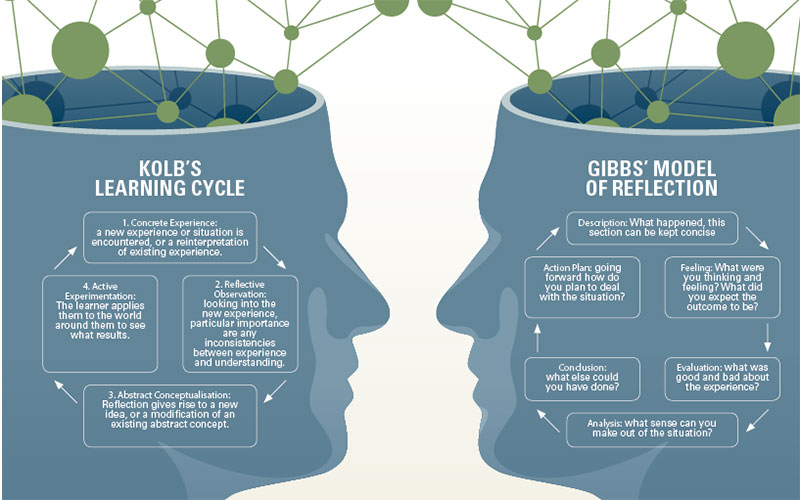Richard Lovie, a Senior Biomedical Scientist working in cytology at York Teaching Hospital NHS Foundation Trust, reflects on reflection.

Reflection has become a part of our working lives, whether we like it or not. I remember a number of years ago, when I was a fresh-faced, newly-qualified biomedical scientist, we had a talk by a nice gentleman who sang the merits of reflection and stated he sat quietly on a Sunday afternoon with a glass of wine and reflected about his past week. You may think this sounds like an excellent idea, or, if you are more like me, you are more likely to just drink your wine while trying to clear up your children’s Lego. It wasn’t until undertaking a management course, that I realised that reflection can actually be a really useful tool and help you formulate your thoughts.
Reflective thinking is a skill, apparently Albert Einstein thought up the theory of relativity while riding a bike, everyone knows the story of Sir Isaac Newton and the apple tree, and the lyrical masterpiece Park Life by Blur was written in Hyde Park. Obviously, working in busy labs as busy professionals we often need to make quick decisions, but I hope this brief article can highlight some methods to employ reflective thinking, in a way to benefit you and maybe give you some ideas to help with CPD.
Something I initially struggled with is that you can reflect upon anything, it doesn’t have to be following a course or a presentation, maybe this sounds obvious but as long as you have learned something, or gained further insight into a situation, you can reflect upon it.
Reflection models
There are a number of different models and methods that can be employed when trying to reflect, these are some of my preferred methods and my opinions on how I have employed them for reflective exercises.
Lesson plan evaluation
This method for a lesson plan evaluation is written from the point of view of the person who gave the talk, it could obviously be modified and extra sections added, or used from the perspective of having attended a talk.
It is useful to get feedback on the group’s experiences, they can provide surprising insight and this can be useful to reflect upon your own feelings and how the lesson went.
Kolb’s learning cycle
Using Kolb’s learning style as a method of reflection is a more cyclic process, it is typically represented by a four stage learning cycle process (see right).
The process stipulates that effective learning is seen, when a person progresses through a cycle of four stages, initially requiring you look at your experience, apply some direct reflection as to what you thought/felt/learnt, then delve a little deeper into the thought process theorising why you feel this way, before working out what you plan to do with this learning how you will apply this as part of the experimenting phase.
This method is useful for reflecting upon situations that have occurred outside of the classroom environment, the subheadings help rationalise thoughts, particularly following challenging experiences. For example you could use Kolb’s learning cycle following a UKAS inspection, the concrete learning would be the feedback from the inspector (good and bad), the reflective observation would allow you to think about how you felt the inspection went, could you have been more organised, was the inspector a bit militant etc, the conceptualisation would allow you to think about how you might change something what are you going to do about that CAPA etc, and the experimentation section would be when you formulated an appropriate action plan to put these procedures in place.
Gibbs’ model of reflection
Gibbs’ model of reflection is also cyclic (see above, right), it is concerned with “learning by doing”. There are a number of separate stages, descriptions of these stages are a little clearer. As with Kolb, effective learning is seen when a person progresses though all the stages – the cycle encourages people to think systematically about experiences they have during a specific situation, event or activity.
The Gibbs model has a number of strengths, firstly you don’t really need to write too much, it works well with concise information, the model can be used to fit a lot of situations, from reflection on a DATIX and how you could improve, to reflection on a full MSc project.
You start with a description of what you are reflecting on – this needs to be clear. The next stage is to do with how you were feeling at the start of the process, what you were hoping to achieve and your evaluation of the situation, this can be as involved as required. Leading into your analysis of the situation – what sense can you make out of it? The conclusion requires you to think about what the evidence supports? The action plan is required to take the situation forward. As long as you have gained some form of learning you can utilise this model.
In conclusion
All methods have strengths and weakness, and some methods may be more situational than others, but I hope I have highlighted some new ways to employ reflective thinking, rather than just the same old “what I have done, what I have learnt, how will I use it in the future” method.
Evaluation
Lesson Evaluation
- Was the lesson reasonable, how the student/s found the difficulty was it too advanced/easy?
- How could the lesson be modified?
- What could be improved to provide a greater understanding of the topic?
Student evaluation
- How did the student behave, were they enthusiastic/interested/bored?
- What feedback did they provide?
- Did they ask appropriate questions (this can help to show they have understood what you are discussing)?
Teacher evaluation
- How do you feel the lesson went?
- What do you intend to change to improve?
Image credit | iStock
